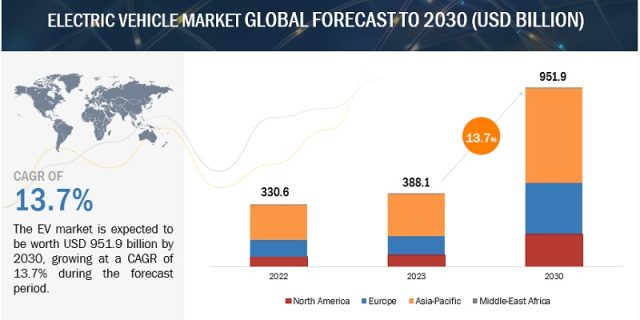
The global EV market is projected to grow from USD 388.1 billion in 2023 to USD 951.9 billion by 2030, registering a CAGR of 13.7%.
The electric vehicle (EV) market is experiencing a remarkable surge in growth, revolutionizing the global automotive industry. With an increasing focus on sustainability and reducing greenhouse gas emissions, governments and consumers alike are embracing the transition to electric mobility. Advancements in battery technology, charging infrastructure, and improved driving range have alleviated the concerns of range anxiety, boosting consumer confidence in EV adoption. Additionally, favorable government policies, incentives, and advancements in manufacturing processes have contributed to making EVs more accessible and affordable to the masses. At present, companies such as BYD (China), Tesla (US), Volkswagen AG (Germany), SAIC Motors (China), and Stellantis (Netherlands), among others. These companies manufacturers EVs and EV components.
Download PDF Brochure @ https://www.marketsandmarkets.com/pdfdownloadNew.asp?id=209371461
FCEVs to be the fastest growing segment during forecast period
The FCEV uses fuel cells to generate electricity for powering the vehicle. Fuel cells in a vehicle generate electricity from the oxygen in the air and compressed hydrogen. FCEVs are completely emission-free as they emit water or heat. FCEVs have been introduced in the US, majorly in California. Many renowned truck manufacturers have already developed fuel-cell electric trucks. For instance, in September 2022, Toyota Motor Corporation (Japan) and Kenworth (US) designed heavy-duty Class 8 FCEVs. Similarly, in January 2023, Adani Group (India) signed an agreement with Ashok Leyland (India) and Ballard Power (Canada) to launch a pilot project for a hydrogen fuel cell electric truck in India Japan and Europe are focusing on the launch of FCEVs. Top FCEVs on the road that are commercially available include Hyundai Tucson FCEV, Toyota Mirai, Hyundai Nexo, and Honda Clarity.
Mid-priced EV segment to be the largest market during the forecast period
A mid-priced vehicle is considered to have a price of USD 30,000 to USD 45,000. This vehicle class has limited features with low emphasis on features such as infotainment, instrument cluster, and other expensive features. China is one of the leading markets for the mid-priced segment. Established automotive manufactures such as Hyundai, General Motors, Honda, and Nissan are also manufacturing mid-priced EVs to acquire higher market shares. Some other mid-priced EVs include BMW 3 Series PHEV, Zeekr One, Ford Mustang Mach-E, Volvo XC40, Renault Megane EV, Hyundai Ioniq 5, Volkswagen ID 4, Kia Niro EV, etc. In 2022, BYD Song Pro/Plus was the best selling mid-priced EV in Asia Pacific region, followed by Tesla Model 3 in Europe and North America. The electric vehicle market forecast for the mid-priced segment is the largest in the Asia Pacific and European regions due to the demand for low-emission vehicles at reasonable prices.
Asia Pacific to be the largest and the fastest growing market by value during the forecast period
The region is home to some of the fastest-developing economies, such as China and India. The governments of these emerging economies have recognized the growth potential of the electric vehicle market trends and, hence, have taken different initiatives to attract major OEMs to manufacture electric vehicles in domestic markets. The region is home to 93 of the world’s most polluted cities, and has a high energy demand. As of 2022, transportation sector in the region accounts for around 14% of overall emissions. Thus, countries in the region, are planning to reduce emissions in the coming years. China, the e-mobility leader in the region, had set a target of over 20% EV sales by 2025, which it had already achieved in 2022 and is expected to have around 35% in 2023. Similarly, countries such as South Korea, Japan and India have also announced plans to shift to EVs in coming years. India for instance, plans to have 30% of its passenger car sales to be electric by 2030. South Korea and Japan are also aiming to be among the world’s top 5 EV producers by 2030. China is also investing significantly in the production of both electric passenger as well as commercial vehicles, with plans for export. OEMs such as BYD plan to open plants in other parts of the world to manufacture electric buses and electric trucks to meet regional demand.
Key Market Players
The electric vehicle market is dominated by BYD (China), Tesla (US), Volkswagen AG (Germany), SAIC Motors (China), and Stellantis (Netherlands), among others. These companies have worked with other players in the EV ecosystem and developed best in class EV technology.
Request Free Sample Report @ https://www.marketsandmarkets.com/requestsampleNew.asp?id=209371461

